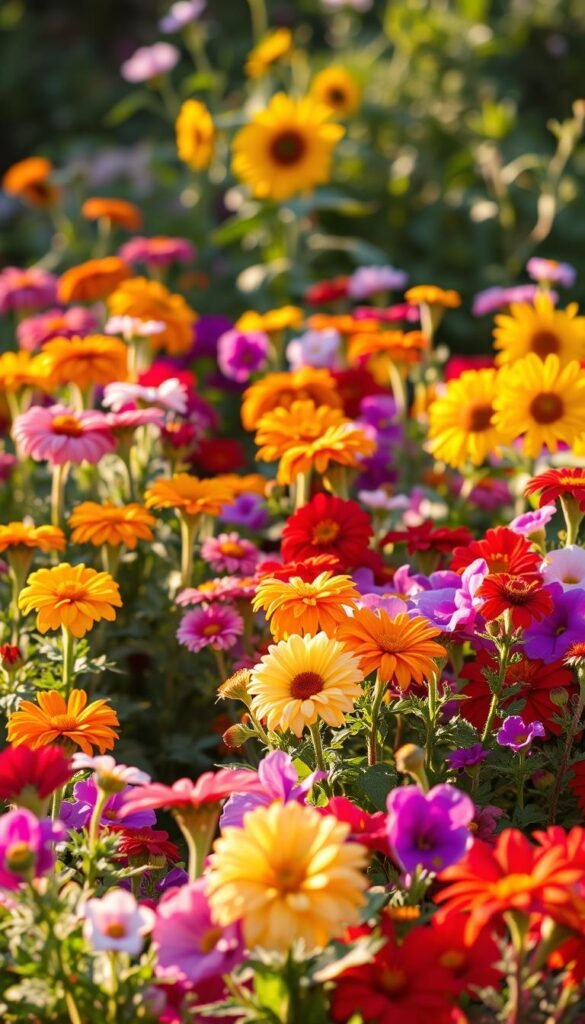Starting a flower garden is a rewarding way to brighten your outdoor space. Even if you’re new to gardening, there are plenty of blooms that thrive with little effort. These picks bring vibrant hues and attract pollinators, making them perfect for first-time growers.
You don’t need a green thumb to grow flowers successfully. Many varieties adapt well to different climates and soil types. With the right choices, you’ll enjoy quick results and lasting beauty.
This guide covers ten easy-care options, ideal for beginners. Learn about sunlight needs, watering tips, and seasonal care to keep your garden flourishing. Let’s dive in!
Why Beginner-Friendly Flowers Are Perfect for Your First Garden
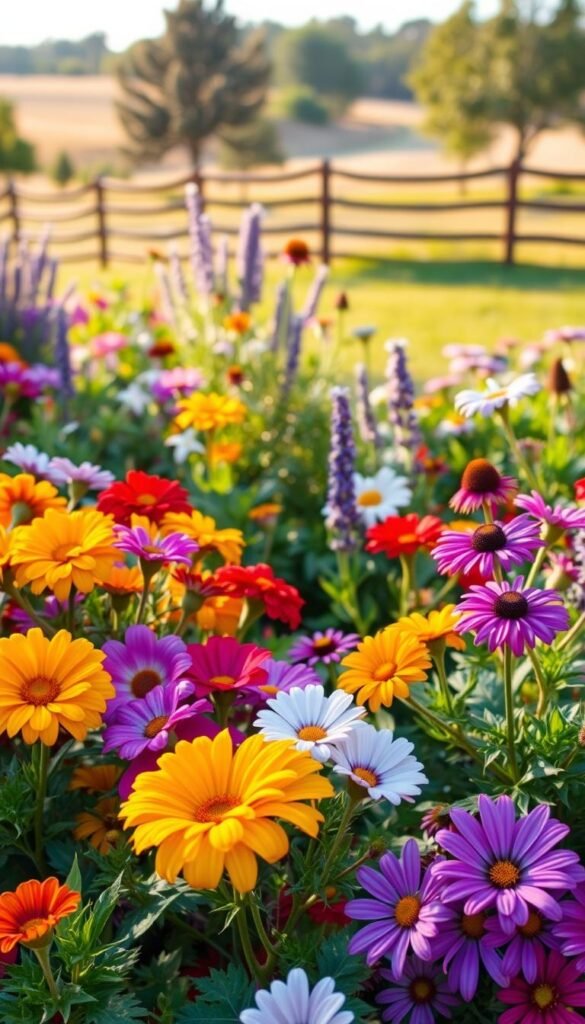
Growing a vibrant garden doesn’t have to be complicated. Some plants thrive with little attention, making them perfect for beginners. These varieties save time and still deliver stunning results.
Low-Maintenance Blooms for Busy Gardeners
Drought-tolerant picks like sunflowers cut watering needs in half. They love full sun and grow tall with minimal care. Marigolds repel pests naturally, so you’ll skip chemical sprays.
Nasturtiums are another smart choice. They flourish in poor soil and even offer edible blooms. For more easy-care flowers, zinnias stand up to heat without staking.
Fast Results to Keep You Motivated
Zinnias sprout in just 7 days, while cosmos appear in 1–3 weeks. Quick bloomers like sweet peas show color in 30–45 days. This rapid progress keeps gardening exciting from day one.
With these picks, you’ll see rewards fast—no green thumb required!
Beginner-Friendly Flowers: Add Color to Your First Garden with These 10 Easy Picks
Brighten your outdoor space effortlessly with these easy-to-grow blooms. Each offers unique perks, from drought resistance to pest control. Let’s explore three top choices for vibrant, low-fuss beauty.
Sunflowers: Bright and Drought-Tolerant
Sunflowers tower up to 16 feet, adding vertical drama to beds or container arrangements. Their golden summer blooms thrive in full sun and need minimal watering.
- Choose ProCut varieties for pollen-free stems, ideal for bouquets.
- Stake tall types to prevent wind damage.
Zinnias: Long-Lasting Cut Flowers
Zinnias dazzle with 4-inch blooms in every hue except blue. The State Fair Mix grows 20–24 inches tall, perfect for borders.
Deadhead Queen Lime varieties to encourage nonstop color. Their vibrant petals last over a week in vases.
Marigolds: Pest-Repelling Powerhouses
Plant marigolds near tomatoes to deter pests naturally. These hardy flowers flourish in dry soil and repel mosquitoes.
Their fiery orange and yellow blooms add warmth to any garden corner.
How to Choose the Right Flowers for Your Climate
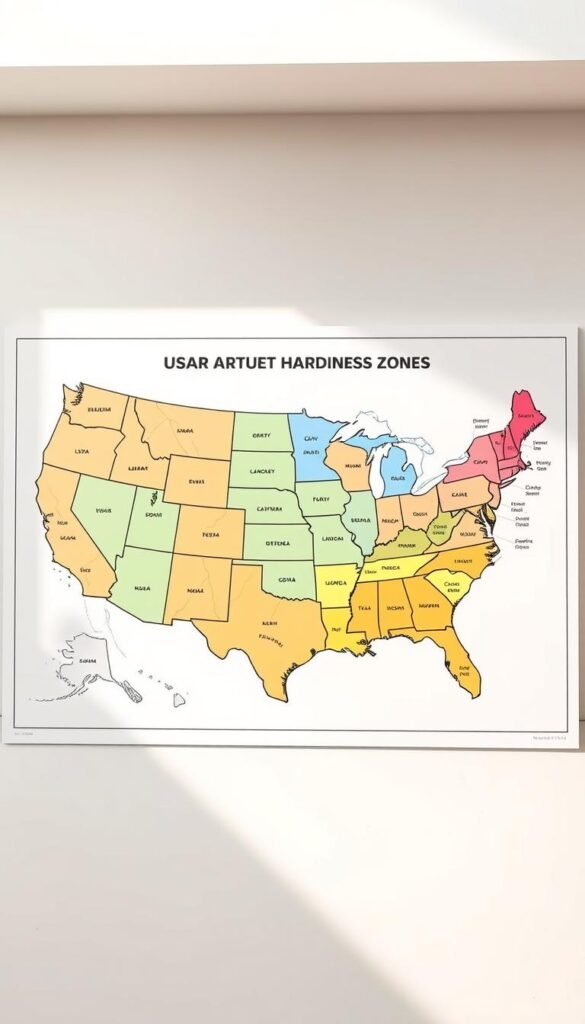
Picking the perfect blooms starts with knowing your local climate. The right match ensures vibrant growth with less fuss. Focus on three factors: your USDA Hardiness Zone, sunlight exposure, and soil conditions.
Understanding USDA Hardiness Zones
The USDA divides North America into 13 zones based on winter lows. For example, lavender thrives in Zones 4–9, while pansies prefer 45–75°F temps. Check your zone using the official interactive map.
Regional quirks matter too. In Oklahoma’s heat, zinnias and cosmos outperform delicate varieties. Urban gardens often create microclimates—warmer near walls or shadier under trees.
Full Sun vs. Shade-Loving Varieties
Full sun plants (6+ hours daily) include sunflowers and zinnias. For shade (3–6 hours), try impatiens or hostas. Match labels to your garden’s light patterns.
Test your soil with a kit to adjust pH or nutrients. Sandy soil? Add compost. Clay-heavy? Mix in perlite for drainage. Simple fixes set the stage for success.
Planting Tips for Guaranteed Success
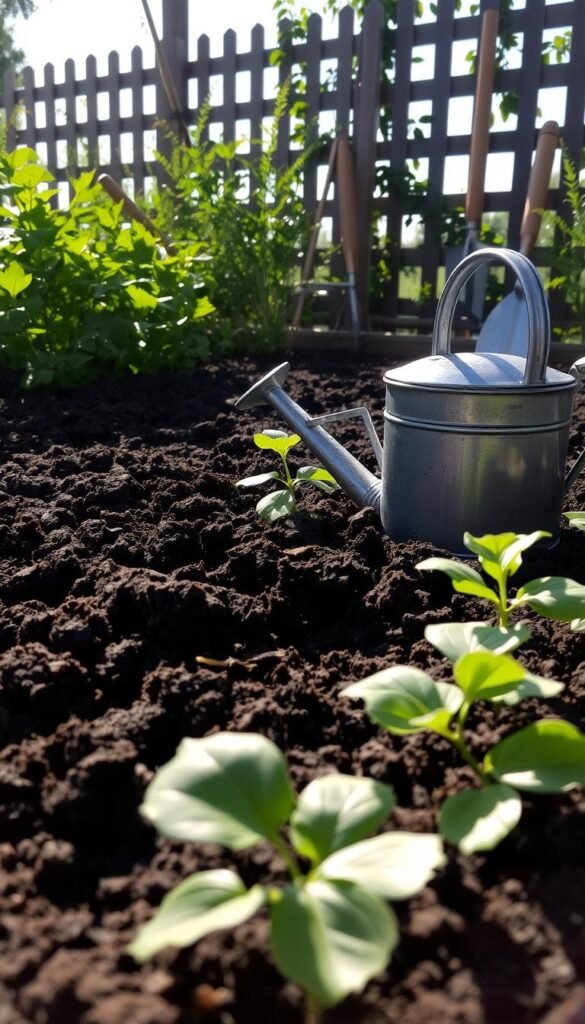
Great soil and smart watering are the secrets to a thriving garden. With these basics in place, your plants will reward you with lush growth and vibrant blooms. Let’s break down the essentials.
Preparing Your Soil Like a Pro
Start by loosening the top 12 inches of soil to help roots spread. Mix in compost (30% of the volume) for nutrients. Test drainage by digging a hole—if water pools, add perlite or sand.
For containers, use a lightweight potting mix. Avoid garden soil—it compacts easily. A balanced 10-10-10 fertilizer gives young plants a strong start.
Watering Schedules for Healthy Blooms
Most flowers need 1 inch of water weekly. Use a soaker hose to prevent leaf diseases. Early morning is best—less evaporation and more sun to dry foliage.
Dahlias and other thirsty varieties need 2–3 deep soakings weekly. Mulch with straw to lock in moisture. For pots, check soil daily—they dry out faster.
Cosmos: Airy and Whimsical Accents
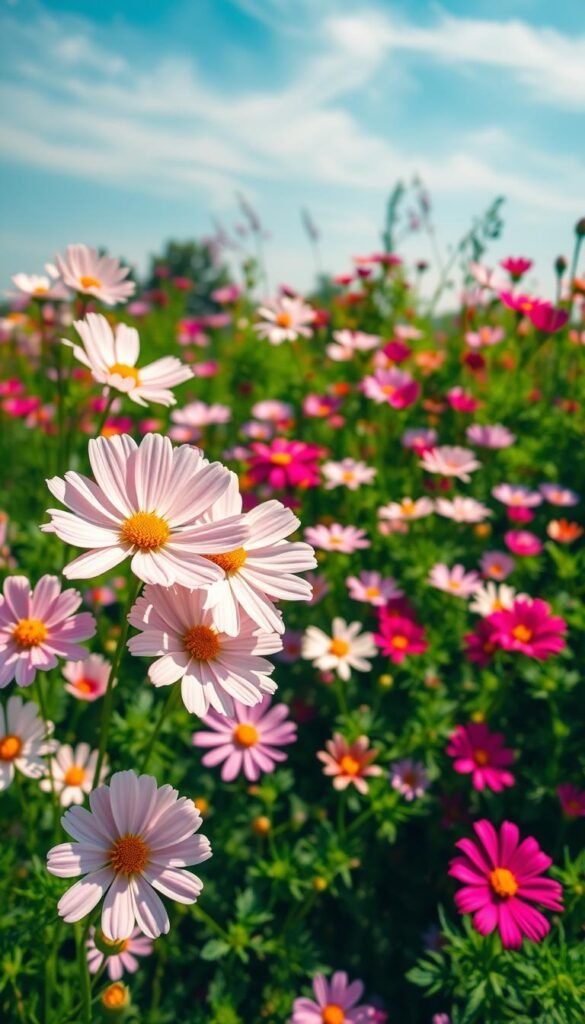
Cosmos bring effortless charm to any garden with their delicate petals. These drought-tolerant blooms sway gracefully in the wind, adding movement and color. Perfect for beginners, they thrive in poor soil and resist pests naturally.
Best Varieties for New Growers
Start with these easy-care types:
- Psyche White: Double blooms that resemble lace.
- Sensation Mix: Bold pinks and crimsons, reaching 4 feet tall.
- Apricot Lemonade: Peach-hued flowers with a citrusy glow.
Taller varieties may need staking. Plant them near fences or use bamboo stakes for support.
Attracting Butterflies with Rubenza Cosmos
The Rubenza variety dazzles with deep burgundy blooms on 18–60″ stems. Swallowtail butterflies flock to its nectar-rich flowers. For continuous color:
- Sow seeds ¼” deep after the last frost.
- Plant every 2 weeks for staggered blooms.
- Pair with veggies like tomatoes to deter pests.
Save seeds from dried flower heads for next year’s garden—no extra cost!
Nasturtiums: Edible and Vibrant
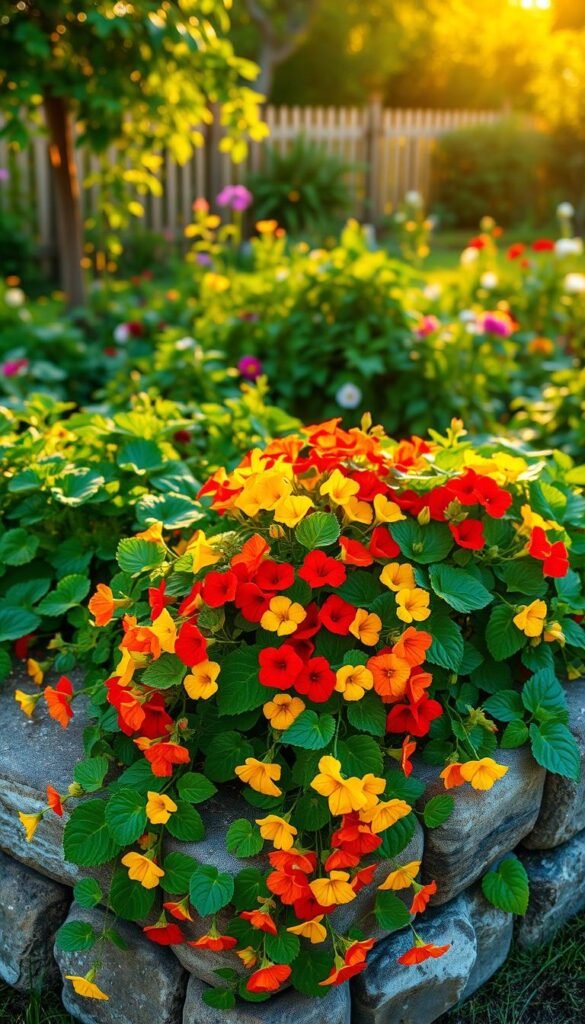
Nasturtiums bring bold hues and peppery flavor to your garden. These fast-growing blooms thrive in poor soil and even repel pests. Best of all, every part—from petals to leaves—is edible, adding a spicy kick to dishes.
Growing from Seed in Poor Soil
Soak seeds overnight or lightly file their coating to speed up sprouting. Plant them ½ inch deep in well-draining soil—avoid fertilizer for more blooms. Nasturtiums trail up to 10 feet, perfect for trellises or hanging baskets.
Try these low-fuss varieties:
| Variety | Color | Best For |
|---|---|---|
| Alaska Mix | Red, Orange, Yellow | Containers |
| Jewel of Africa | Peach, Cream | Ground Cover |
Using Blooms in Salads
Pick flowers in the morning for peak freshness. Their peppery taste pairs well with:
- Pan-seared halibut with nasturtium butter.
- Summer salads topped with petals.
- Infused vinegar for a floral twist.
Plant them near veggies like cucumbers to deter aphids naturally. A true multitasker, nasturtiums add color to your garden and flavor to your plate!
Pansies and Petunias: Cool-Weather Champions
Cool-weather blooms like pansies and petunias keep gardens lively when temperatures drop. These hardy plants thrive in crisp air, offering vibrant hues from early fall through spring in warmer zones. Perfect for beginners, they need simple care to flourish.
Extending Blooms into Fall
Pansies bloom from winter to spring in Zones 6–10. Protect them from frost with mulch or cloches. For petunias, apply a balanced fertilizer every 3 weeks to fuel continuous flowering.
Try these tricks for prolonged color:
- Use shade cloth to shield plants from midday heat.
- Deadhead spent blooms weekly to encourage new buds.
- Overwinter potted petunias indoors in cooler zones.
Container Gardening Ideas
Create eye-catching arrangements with the thriller-filler-spiller technique. Pair Rockapulco® petunias (thriller) with trailing lobelia (spiller). For hanging baskets, mix wave petunias and bacopa.
| Container Type | Plant Combo | Best For |
|---|---|---|
| Window Box | Pansies + Ivy | Small Spaces |
| Patio Pot | Petunias + Sweet Alyssum | Full Sun |
Dahlias: A Surprising Beginner Favorite
Dahlias might seem intimidating, but they’re easier to grow than you think. Their spectacular blooms come in countless colors and shapes, from petite pompons to dinner-plate sizes. With proper tuber care and simple support, these stunners thrive in full sun with minimal fuss.
Selecting Healthy Tubers
Start with firm, plump tubers that show visible “eyes” (growth points). Avoid any with soft spots or mold. Space them 12–18″ apart when planting—closer for dwarf varieties, wider for giant types.
Consider these reliable choices for beginners:
| Variety | Bloom Size | Height |
|---|---|---|
| Bishop of Llandaff | 4 inches | 3 feet |
| Happy Single Princess | 3 inches | 2 feet |
| Karma Choc | 6 inches | 4 feet |
Staking for Strong Stems
Tall varieties need support to prevent wind damage. Install bamboo stakes at planting time to avoid piercing tubers later. Use soft twine in a figure-eight pattern to secure stems without constriction.
For bushier plants, pinch back the center stem when it reaches 12 inches. In cold climates, dig up tubers after frost, dry them for 3 days, and store in peat moss at 40–50°F.
With these basics, your dahlias will reward you with months of vibrant color. They prove that stunning gardening results don’t require advanced skills—just smart preparation.
Creating a Pollinator-Friendly Garden
Transform your outdoor space into a buzzing paradise with pollinator-friendly blooms. These plants do more than beautify—they support bees, butterflies, and other vital species. With smart choices, you’ll nurture biodiversity while enjoying low-maintenance color.
Flowers That Bees and Butterflies Love
Sunflowers are pollinator magnets, attracting over 35 species. Their broad centers offer easy access to nectar. For continuous blooms, try Ruby Eclipse varieties with red-tipped petals.
Lavender doubles as a mosquito repellent and bee favorite. Plant it near seating areas for a fragrant, pest-free zone. Pair with vibrant container gardens for layered appeal.
Companion Planting Strategies
Marigolds and tomatoes are a classic duo. The flowers repel nematodes, protecting your crop. For night pollinators like moths, add moonflowers or evening primrose.
Boost success with these tips:
- Group native plants by region (e.g., milkweed for monarchs).
- Leave wild corners for predatory insects.
- Swap pesticides for neem oil sprays.
With these steps, your garden becomes a thriving ecosystem—effortlessly.
Start Planting Your Colorful Garden Today
Your journey to a vibrant outdoor space begins with smart planning and easy-care blooms. In just 30 days, you’ll see progress—start by thinning seedlings at 3 weeks for stronger plants. Track growth with a bloom journal, noting sunlight and watering patterns.
Save time and money by joining local seed swaps or dividing perennials. Master Gardener hotlines offer free advice when you hit snags. Celebrate milestones, like your first bouquet—snap photos to share the joy!
Every flower garden starts with a single seed. Whether you grow flowers in pots or beds, these steps set beginners up for success. Now’s the perfect time to dig in and watch your space burst with color.
